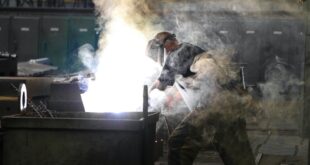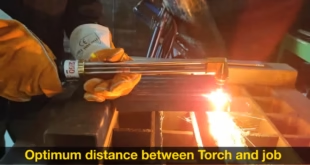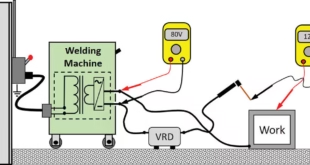A Comprehensive Guide to Preventing Safety Violations
Introduction
Welding is a fundamental process in various industries, playing a pivotal role in the fabrication of structures, machinery, and products. However, despite its importance, welding poses numerous safety hazards that must be diligently addressed to ensure the well-being of workers and the integrity of the work environment. Safety violations in welding can lead to accidents, injuries, and even fatalities. In this article, we delve into some common safety violations in welding and discuss measures to prevent them, promoting a safer working environment for all.
Common Safety Violations in Welding

Inadequate Personal Protective Equipment (PPE)
One of the most critical aspects of welding safety is the proper use of personal protective equipment. This includes welding helmets, gloves, flame-resistant clothing, and respiratory protection. Failure to wear appropriate PPE increases the risk of burns, eye injuries, and inhalation of hazardous fumes and particles.
Insufficient Ventilation
Welding generates hazardous fumes and gases that can be detrimental to both short-term and long-term health. Inadequate ventilation systems in welding areas can lead to poor air quality, potentially causing respiratory issues, dizziness, and other health problems for workers.
Lack of Training and Education
Welding is a skilled trade that requires thorough training and experience. Inadequately trained welders are more likely to make mistakes, leading to safety violations. Proper training not only teaches proper welding techniques but also emphasizes safety practices and hazard recognition.
Improper Storage of Flammable Materials
Welding involves the use of flammable gases and materials, making proper storage crucial. Failure to store these materials correctly can result in fires, explosions, and other catastrophic incidents.
Unsafe Work Area Setup
A cluttered or disorganized work area can lead to tripping hazards, hinder movement, and create an environment ripe for accidents. Welding stations should be organized, free from clutter, and equipped with adequate lighting.
Preventing Safety Violations in Welding
Comprehensive Training
Employers must provide thorough training to welders, covering not only welding techniques but also safety protocols, hazard identification, and emergency procedures. This knowledge empowers welders to make informed decisions in challenging situations.
Personal Protective Equipment (PPE)
Employers should ensure that all workers have access to and consistently wear the appropriate PPE for the specific welding tasks. Regular inspections of PPE can help identify and replace worn-out equipment.
Effective Ventilation
Proper ventilation systems, including exhaust fans and fume extraction systems, should be installed in welding areas to reduce exposure to harmful fumes and gases. Regular maintenance of these systems is essential to their effectiveness.
Clear Work Area Guidelines
Implement clear guidelines for organizing and maintaining the welding work area. Adequate lighting, proper storage of materials, and a clutter-free environment contribute to a safer workspace.
Regular Inspections
Conduct routine inspections of equipment, tools, and safety protocols. Identify potential safety violations and address them promptly. Encourage reporting of any safety concerns by workers.
FAQs
1. What are some common safety violations in welding?
Common safety violations in welding include inadequate personal protective equipment (PPE) usage, insufficient ventilation, lack of proper training, improper storage of flammable materials, and unsafe work area setup.
2. Why is personal protective equipment (PPE) crucial in welding?
Personal protective equipment is vital in welding to protect workers from potential hazards such as burns, eye injuries, and exposure to harmful fumes. Welding helmets, gloves, flame-resistant clothing, and respiratory protection are essential components of PPE.
3. How does inadequate ventilation impact welding safety?
Inadequate ventilation in welding areas can lead to poor air quality due to the release of hazardous fumes and gases. This can cause respiratory issues, dizziness, and other health problems for workers over time.
4. Why is proper training important for welders?
Proper training is crucial for welders to ensure they have the necessary skills to perform their tasks correctly and safely. Training not only covers welding techniques but also emphasizes safety protocols, hazard identification, and emergency procedures.
5. How can employers create a safer welding work environment?
Employers can create a safer welding work environment by providing comprehensive training, ensuring the use of appropriate personal protective equipment, installing effective ventilation systems, maintaining organized work areas, and conducting regular inspections to identify and address safety violations.
6. What is the significance of hazard recognition in welding safety?
Hazard recognition is essential in welding safety as it empowers workers to identify potential dangers in their work environment. Being able to recognize hazards allows workers to take appropriate precautions and prevent accidents, ensuring a safer welding process overall.
Conclusion
Safety violations in welding can lead to severe consequences, affecting both the health of workers and the integrity of the work being done. By addressing common safety violations and implementing preventive measures, employers can create a safer working environment that promotes the well-being of their workforce. Comprehensive training, proper use of personal protective equipment, efficient ventilation, organized work areas, and regular inspections all play crucial roles in minimizing the risk of safety violations and enhancing overall welding safety. Ultimately, investing in safety not only prevents accidents but also contributes to higher productivity and a more positive workplace culture.
 Welding of Welders All about Welding and Welders
Welding of Welders All about Welding and Welders



